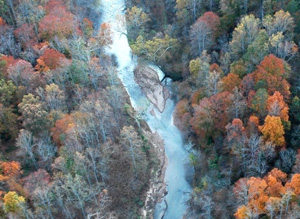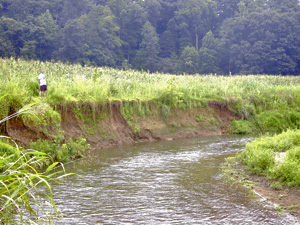Stream Assessments
Most streams in the Land Use Study failed Virginia’s biological standard. Click here to view the assessment map. The biological standard tells us whether streams support a variety of life forms. Streams with more life have better water quality, and can provide better services to humans. Such services include water supply, recreation, and aesthetic enjoyment.
We collected data at 51 sites. We can extrapolate stream conditions around the watershed from the data that we collected (see 20-Year Projection).
Apart from the Land Use Study, StreamWatch conducts regular stream assessments at long-term monitoring sites. Each assessment covers a different time window. For our most recent assessment, visit our scientific reports.
Forested buffers along streams can protect and improve stream health

[photo courtesy of Martin Johnson, TJSWCD]
A forested stream buffer is an area of trees and undergrowth located alongside streams which can help to filter sediment, nutrients and other pollutants before they enter the stream. Forested stream buffers mean cooler water temperatures, higher oxygen levels, more stable stream banks, and more food for stream bugs (in the form of dead leaves). Buffers help stream life thrive!
Our data suggest that forested streamside buffers can offset some of the negative impacts of watershed deforestation and other landscape disturbance. This is reason for optimism. It is certainly easier to plant a buffer along a stream than to plant a forest throughout a watershed. However, the mitigating effects of buffers are limited. For instance, we cannot expect a buffer to restore excellent health to an urban stream.
Cattle operations did not have a noticeable impact on overall Rivanna basin stream health

Above: Icons show locations of herds or small groups of cattle.
Unlike development and deforestation, cattle operations did not have a big overall impact in the Rivanna basin. We cannot infer that Rivanna basin cattle operations have no influence on stream biological condition. However, we did not detect any relationship at the landscape scale. We emphasize, though, that we did not study local impacts. For instance, we did not situate our sampling sites near cow pastures or otherwise try to detect cattle effects in streams near cattle operations. We also note that Rivanna cattle operations may be generally less intensive than in some other areas of Virginia and the mid-Atlantic region.
Unstable stream banks and excess sediment appear to affect the health of many Rivanna streams

Bank erosion and excess sediment are common problems in Rivanna streams. Our data suggest that these conditions adversely affect stream biology, though not as powerfully as landscape disturbance.
